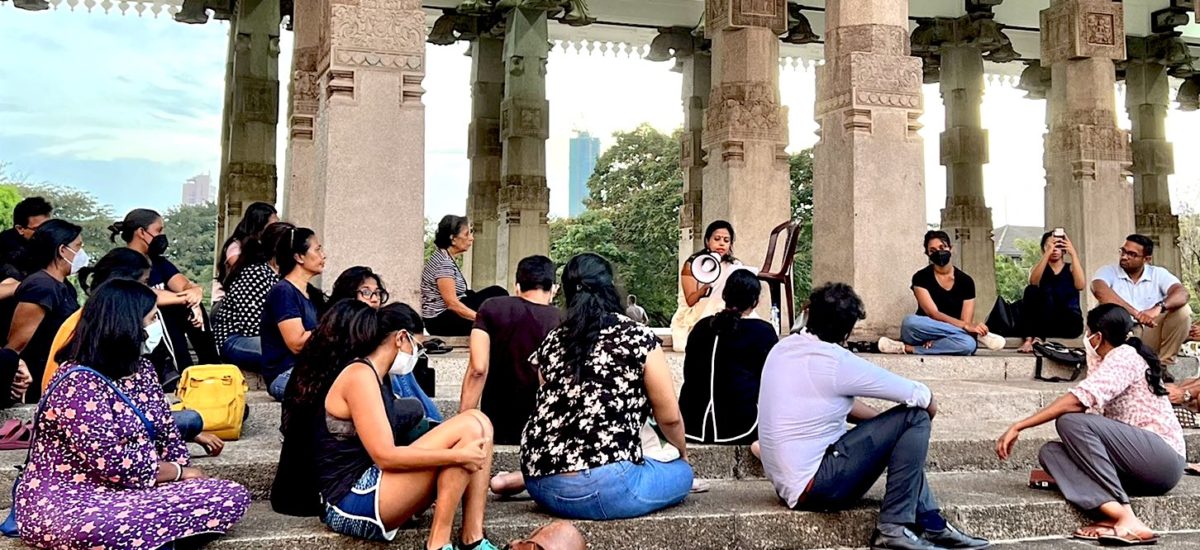Photo courtesy of Twitter
Following the token general strike last week against the backdrop of the ongoing protests to oust President Gotabaya Rajapaksa’s authoritarian regime, a few school principals have been grumbling about students being deprived of education. They were wondering whether teachers should be recalled from the sites of struggle back to the classroom if the strikes continue so students could reap the “real” benefits of education by attending regular classes.
It’s an undeniable fact that students have been dealt a severe blow due to Covid-19, particularly Sri Lankan students, due to a lack of technological infrastructure.But what’s unsettling is the principals’ single tunnel vision of education. The reductionist view of education emphasises more on teachers and students teaching and learning within four walls of what is called a school – the artificial world of teachers and learners. The harsh realities lying outside the school boundary are considered a threat to education.
In this narrow view, the end and aim of education is to churn out cloned individuals euphemistically called professionals to fit into the economic order that caters for the thin sliver of the privileged class. In turn, from this hotbed sprouts the plutocracy that has come to plague the country on all fronts. This brand of education does not act as a real life emancipatory and morally responsible agency. It defangs the students and domesticates them into submissive non-citizens. So along with Rousseau, we have to ask, we have lawyers, we have doctors, we have engineers but where are the citizens?
One of the primary objectives of education must be to nurture free human beings who can live without fear, who can speak truth to power. At a deeper level, today’s societal catastrophes are also a symptom of a commodified form of education – teaching to the test. Paulo Freire, the Brazilian critical educationist, using the analogy of the bank labelled this form of education as the “banking method of education”. According to this model, the student is considered to be in a deficit state and the teacher becomes the one who deposits his knowledge into these empty vessels, and at regular competitive exams retrieves it as one would withdraw money from one’s savings deposits.
It is, therefore, important that teachers and students not only learn to read the word (literacy) but collaboratively attempt to read the world around them and engage with it to transform it if necessary. Our education system, which is a strong conditioning apparatus like religion and nationalism, has turned most of us into submissive subjects. But it is heartening to see at least the current youth-led popular uprising against the status quo is not only demanding the abolition of the draconian executive presidency but also, by implication, the abolition of this dehumanising model of education.
In this sense, the protest struggles at the Galle Face and around the country should not be seen as something that minimise education but as events that expand education. It’s an intense moment of learning that can connect the real world to the classroom. Every critical educationist should respond to this unprecedented event or popular youth led non-violent uprising as a matter of urgency. Instead of ignoring it as a chaotic upheaval from which students must be cushioned or extricated, they must grab it and exploit it as a rare educational moment.
I suggest that school principals, teachers and students collaborate and devise lessons and lesson plans around this popular citizens’ struggles. They could visit the site of the struggle to interview protestors; conduct research about civic activism, power and politics; teach/learn about the connection between dynastic politics, political mismanagement and corruption, economic catastrophes and dictatorships; and look into how domestic political and economic crises have global and regional implications. Students and teachers could create opportunities to exploit IT skills to produce documentaries, mockumentaries or infotainment videos for their school media units; they could engage in social consciousness raising photographic exhibitions by organising galleries for photographs taken at the site of the struggle or art walls; art students could produce a street theatre script and enact it for the public; they could run mini student mock parliamentary sessions to discuss the ills of wrong economic policies or turn them into constitutional experts to determine the best constitution for the country. Language teachers could teach them vocabulary, comprehension or essay writing; literature students could draw parallels or engage in comparative studies with texts that they are studying which deal with such issues that have caused the current crisis in Sri Lanka. And the list goes on.
The opportunities for creating innovative and refreshing student-centred lessons and lesson plans based on this real life experience of the students and their families will become more authentic. Doing so will make education relevant and emancipatory. This way, educators could put the cookie cutter curriculum on hold for a moment. As John Dewey, the renowned American educationist famously said, “Education is not preparation for life; education is life itself.”


